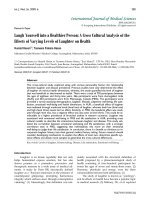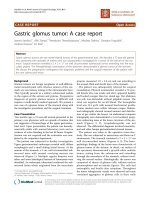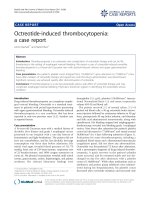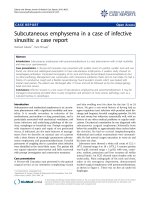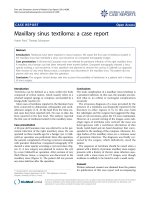Báo cáo y học: "Symplastic scrotal leiomyoma: a case report" ppt
Bạn đang xem bản rút gọn của tài liệu. Xem và tải ngay bản đầy đủ của tài liệu tại đây (265.43 KB, 3 trang )
BioMed Central
Page 1 of 3
(page number not for citation purposes)
Journal of Medical Case Reports
Open Access
Case report
Symplastic scrotal leiomyoma: a case report
Joe Philip*
1,2
, Ramaswamy Manikandan
2
, Palaniswamy Vishwanathan
1
and
Joseph Mathew
3
Address:
1
Department of Urology, Royal Cornwall Hospital, Truro, TR1 3LJ, UK,
2
Department of Urology, Royal Liverpool University Hospital,
Liverpool, L7 8XP, UK and
3
Department of Pathology, Royal Cornwall Hospital, Truro, TR1 3LJ, UK
Email: Joe Philip* - ; Ramaswamy Manikandan - ;
Palaniswamy Vishwanathan - ; Joseph Mathew -
* Corresponding author
Abstract
Introduction: Scrotal leiomyomas are rare tumours which are essentially benign. Recurrence and
malignant transformation to leiomyosarcoma have been reported. However, a specific subgroup
with increased bizarre nuclei showing increased mitosis raises the need for a closer follow-up. We
report on such a case.
Case presentation: We report the case of a 65-year-old man who underwent a scrotal lump
excision. Histology showed a well defined leiomyoma. The presence of nuclear pleomorphism and
mitoses, just falling short of the criteria for malignancy, made prediction of biological behaviour
difficult. The patient remains well on 4-year follow-up.
Conclusion: Histological evidence of increased mitosis raises the need for sustained follow-up in
view of the malignant potential from the extent of mitosis. Immunohistochemistry helps in
identifying those patients warranting close follow-up.
Introduction
Leiomyoma of the scrotum is a rare entity described as a
benign pathology. Immunohistochemistry helps differen-
tiate this condition from a leiomyosarcoma. However, we
raise the entity of symplastic scrotal leiomyoma with
bizarre nuclei and increased mitosis on immunohisto-
chemistry. The pattern of growth in this distinct subset is
not known. Theoretically, there is a higher risk for malig-
nant transformation. We discuss this situation and suggest
the necessity for close follow-up.
Case presentation
A 65-year-old man presented with a single well-defined,
soft, non-tender, mobile right scrotal lump, increasing in
size for 4 weeks, with no palpable connection to his testis,
epididymis or spermatic cord. Herniae and palpable
inguinal lymph nodes were absent. An ultrasound of the
testes as well as testicular tumour markers were not under-
taken as the testes were considered normal on clinical
examination with the lesion being a testicular adnexal
mass. The lump was excised from the scrotal dartos layer.
Histology showed a well-defined leiomyoma made up of
spindle cells in which numerous degenerating uni- and
multinucleate tumour giant cells (symplastic, bizarre)
were identified; nuclear pleomorphism and four mitoses/
ten high power fields were also noted. The tumour was
smooth muscle actin- and desmin-positive, confirming
smooth muscle phenotype (Fig. 1). The patient was dis-
ease-free at 4-year follow-up.
Published: 9 September 2008
Journal of Medical Case Reports 2008, 2:295 doi:10.1186/1752-1947-2-295
Received: 23 January 2008
Accepted: 9 September 2008
This article is available from: />© 2008 Philip et al; licensee BioMed Central Ltd.
This is an Open Access article distributed under the terms of the Creative Commons Attribution License ( />),
which permits unrestricted use, distribution, and reproduction in any medium, provided the original work is properly cited.
Journal of Medical Case Reports 2008, 2:295 />Page 2 of 3
(page number not for citation purposes)
Discussion
Scrotal wall leiomyomas are rare, usually asymptomatic
tunica dartos tumours, commonly seen in middle-aged
Caucasian men [1]. They are typically slow growing pre-
senting in the fifth decade of life [2].
They are often less than 3 cm in diameter and are more
commonly solitary than multiple [3]. The solitary group is
further categorised as angioleiomyoma, genital-areolar
leiomyoma and piloleiomyoma [3]; it has been suggested
that these tumours are myofibroblastic in origin [4]. Typ-
ically, these lesions are poorly circumscribed, non-encap-
sulated tumours consisting of uniform spindle shaped
cells arranged as interlacing fascicles with little or no ple-
omorphism, or mitoses [1,3].
Simple surgical excision is curative; surgery for large
lesions should be conservative if its cutaneous origin is
clearly separate from the testis or adnexal structures [5].
Radiation should be avoided as it may induce malignant
transformation [6]. Recurrence and malignancy have been
described [1].
Conclusion
In symplastic scrotal leiomyoma, the presence of nuclear
pleomorphism and mitoses, just falling short of the crite-
ria for malignancy, makes prediction of biological behav-
Histology showsFigure 1
Histology shows: (a) A well-defined lesion, with a pseudocapsule, made up of interlacing bundles of regular smooth muscle cells
(N) with apparent hypercellular areas (open arrow); residual bundles of dartoic muscle are seen in adjacent fibrovascular con-
nective tissue (arrow heads) (7.5×; haematoxylin and eosin). (b) & (c) Degenerating uninucleate (curved arrows) and multinu-
cleate giant cells (straight arrow) are seen adjacent to typical leiomyomatous areas (N) (120×; haematoxylin and eosin). (d)
Tumour is smooth muscle actin-positive (30×; immunoperoxidase stain, diaminobenzidine method). (e) Tumour is also desmin-
positive (30×; immunoperoxidase stain, diaminobenzidine method).
Publish with BioMed Central and every
scientist can read your work free of charge
"BioMed Central will be the most significant development for
disseminating the results of biomedical research in our lifetime."
Sir Paul Nurse, Cancer Research UK
Your research papers will be:
available free of charge to the entire biomedical community
peer reviewed and published immediately upon acceptance
cited in PubMed and archived on PubMed Central
yours — you keep the copyright
Submit your manuscript here:
/>BioMedcentral
Journal of Medical Case Reports 2008, 2:295 />Page 3 of 3
(page number not for citation purposes)
iour difficult. Immunohistochemistry helps identify this
subgroup of patients who warrant close follow-up in view
of the malignant potential.
Consent
Written informed consent was obtained from the patient
for publication of this case report and any accompanying
images. A copy of the written consent is available for
review by the Editor-in-Chief of this journal.
Competing interests
The authors declare that they have no competing interests.
Authors' contributions
JP conceived the case report, collected the patient's infor-
mation and was involved in writing the manuscript. PV
collected the patient's information and was involved in
writing the manuscript. RM helped collate patient infor-
mation and was a major contributor in writing the manu-
script. JM conceived the case report with JP, performed the
histological examination and was involved in writing the
manuscript. All authors read and approved the final man-
uscript.
References
1. Siegal GP, Gaffey TA: Solitary leiomyomas arising from the
tunica dartos scroti. J Urol 1976, 116:69.
2. Chiong E, Tan KB, Siew E, Rajwanshi A, See H, Esuvaranathan K:
Uncommon benign intrascrotal tumours. Ann Acad Med Singa-
pore 2004, 33:351.
3. Ragsdale BD: Tumours of fatty, muscular and osseous tissue:
fat as a tissue, an organ and a source of tumors. In Lever's His-
topathology of the Skin 8th edition. Edited by: Elder D, Elenitsas R,
Jaworsky C, Johnson B Jr. Philadelphia, PA: Lippincott-Raven;
1997:457-502.
4. Holstein AF, Otlandini GE, Baumgarten HG: Morphological analy-
sis of tissue components in the tunica dartos of man. Cell Tis-
sue Res 1974, 154:329.
5. Das AK, Bolick D, Little NA, Walther PJ: Pedunculated scrotal
mass: leiomyoma of scrotum. Urology 1992, 39:376.
6. Sherwani RK, Rahman K, Akhtar K, Zaheer S, Hassan MJ, Haider A:
Leiomyoma of scrotum. Indian J Pathol Microbiol 2008, 51:72.
